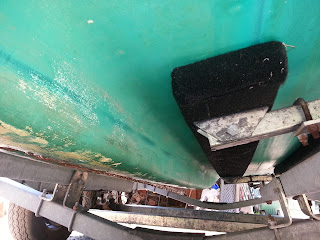After a couple days of working with the
keel, it became obvious that what I really needed to do was raise the
boat up high enough to force the keel down completely, then grind it
down to bare metal, fair, then epoxy it. When I bought the boat my
only self imposed rule was that I would not start any repairs that
would make it unsailable this season, and keeping with that I jacked
the keel back up from underneath, reserved to let it stay that way
for the rest of the waning summer, and work on the fiberglass repair
where water was leaking in at the former rudder trunk, a common
problem for these boats. The Aquarius is one of the very few boats with a swing keel that is self righting with the keel in the up position.
This eight inch protrusion under the boat is encapsulated lead.
Termed a "skiff keel" by the builder, its six hundred pounds
provides righting momentum even with the cast iron keel raised,
while only drawing twelve inches of water.
The Eejit was fine while floating,
leaked a couple cups an hour while under sail, and about a gallon per
hour while under power. This is because when motoring, the outboard
pushes the stern of the boat down as a function of moving it forward.
What used to be the rudder trunk in the cockpit was now a removable
plug, and had been replaced by a swing up after market rudder on the
transom.
Fiberglass work is not as
complicated as it seems. I used to do a fair bit of it keeping my
surfboards floating back in my twenties, and decided to put those
skills to use on the Eejit.
I took a grinder to the trunk, and
sanded it down to clean fiberglass along the complete top edge all
the way around. I pre-cut the fiberglass cloth to fit, overlapping at
least two inches on either side of the seam. Next, donning disposable
gloves, mixed the fiberglass resin. I usually mix my resin a little
hotter than it calls for. I find I generally do not need the extra
working time, and having it kick off a little earlier keeps the resin
from dripping and sagging as much. I usually use an old soup can to
mix it, and a disposable paintbrush to apply it. First painting the
area liberally with resin, then pressing the cloth to it, and finally
“painting” on more resin until the cloth is saturated, and
smoothing the cloth by hand and brush. It is important to watch the
repair as it cures. Often times (on a corner or curve) the cloth will
lift away from the repair leaving an air bubble underneath. Be sure
to take the brush and apply more resin as necessary, pushing down and
working out any bubbles that form. With the resin mixed hot this
process is both quicker and easier. Remember smoothing before it
dries is much easier than sanding and re-coating with resin later.
ground down, and fiberglass matt cut to size
Repair cured
After dropping it back in the water
and sailing for four days (Including a few hours motoring) I am very
happy to report I have a dry cabin floor! About the only downfall I
have found with this boat (design wise) is that is does not have a
bilge. While the cockpit is self bailing, any water coming through
the hull or deck ends up on the floor just in front of the
kitchenette. In one sense this is good, because while you expect a
wooden boat to take on a little water, a fiberglass one should not,
and you will notice it right away.


